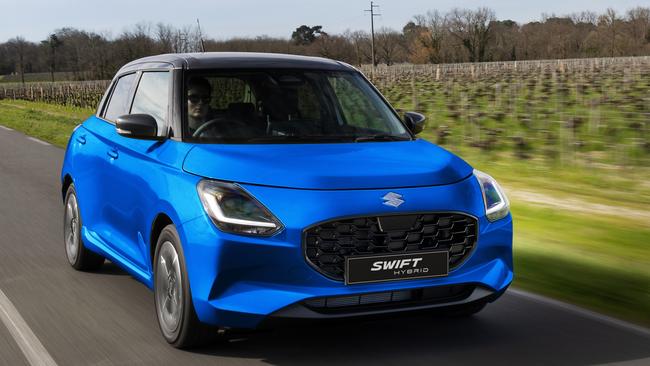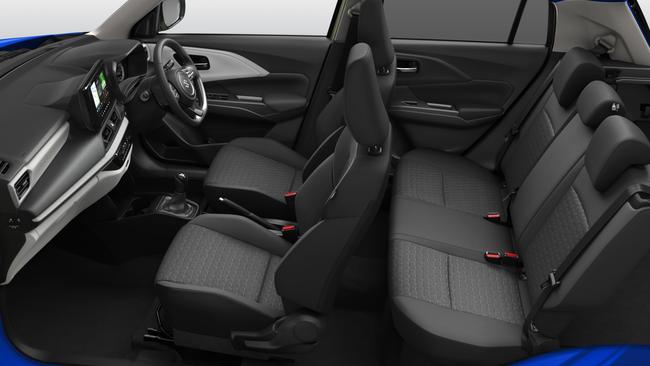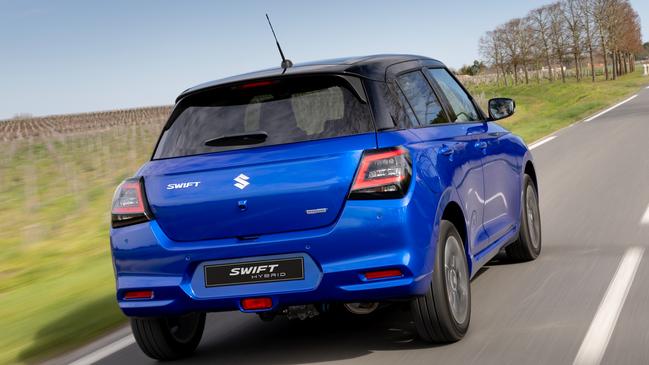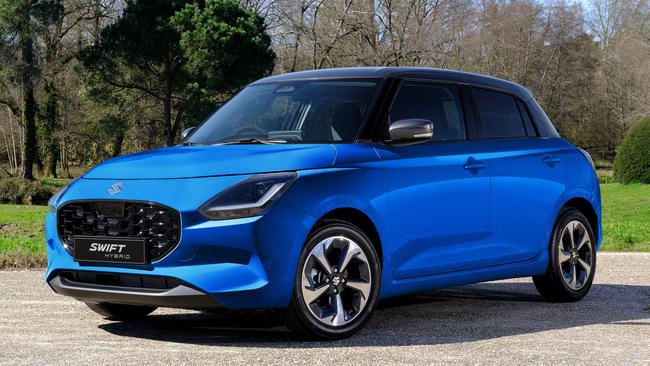Suzuki Swift review: affordable hatch misses out on safety tech
Small cars have become more expensive as manufacturers fit the very latest in crash avoidance technology. But this new model sticks to the basics.
New Cars
Don't miss out on the headlines from New Cars. Followed categories will be added to My News.
Suzuki has launched its new generation Swift city hatchback complete with mild hybrid power.
Here are five things you should know.
It’s one of very few decent cars costing less than $25,000
The cost of living crisis is tough, so a frugal, well-equipped and handsome hatchback costing $24,490 drive-away is most welcome.
It’s Australia’s cheapest mild hybrid, and for your dollars there’s little to rival the new Swift.
There’s the smaller Kia Picanto, Hyundai’s little Venue SUV and Suzuki’s own toylike Ignis. A key rival is the much-improved new MG3 in hybrid guise, but the cheapest of those is $3500 above the entry-level manual Swift.
Australia’s car showrooms brim with high-specification and increasingly pricey vehicles, making the simplified Swift a refreshing change for budget buyers.
Keeping costs down, the entry level has a five-speed manual (a CVT auto’s $2500 extra), steel wheels with hubcaps, rear drum brakes, scratchy hard cabin plastics, a cheapie steering wheel, no arm rest and no seat height adjuster.

But the demanded specification is there
Stuff the niceties. Some buyers just want connectivity, and it’s here the Swift shines. Standard are LED headlights, a 9-inch infotainment screen with satnav, wireless Apple CarPlay and wired Android Auto, rear parking sensors and keyless start. Suzuki’s nailed the non-negotiables.
The volume seller will be the mid-spec auto-only Swift Hybrid Plus for $28,490 in the traffic.
It adds 16-inch alloys, a leather steering wheel, heated two-tone cloth seats, better audio and a USB-C port alongside the standard USB-A.
The flagship GLX is $29,490 drive-away, adding polished alloys, paddle shifters, auto climate control and a wireless charging pad. Safety across all models includes auto emergency braking, adaptive cruise control, lane-keep assist, lane-departure warning and traffic-sign recognition.
Rear cross-traffic alert and blind-spot monitor only feature on Plus and GLX, while none have a front centre airbag or reverse auto braking.
Cconcerningly, recent Euro NCAP safety tests awarded the Swift only three stars.
The car scored poorly in the physical crash tests, with poor, weak and marginal ratings for adult and child occupant protection.

It’s a cracking little thing to drive
Light means fun, and the Swift weighs just 919kg in manual guise and 957kg in auto. Battery packs alone in large EVs tip the scales at similar weights.
This little Suzuki playfully darts around on its skinny tyres, the steering’s responsive and there’s neat balance when quickly changing direction. It’s a happy, fun thing to punt through town.
Its diminutive nature means it can jar over city streets’ larger road imperfections, but otherwise it’s a settled, comfy ride.
Most impressive are its high-speed manners.
It belies its size by holding station at 110km/h and keeping most of the road noise at bay.
A rare bonus are driver aids such as lane-keep and steering assist being opt-in rather than opt-out.
You’re not nannied unless you demand it.

But it’s not a proper hybrid
No wonder Aussie buyers get confused with the catch-all “hybrid” name. The Swift is a “mild” hybrid, so it can’t drive using only an electric motor.
Instead, there’s an integrated starter generator, which functions as a generator and a tiny electric motor, with a small battery recharging when brakes are applied.
In plain English, the engine turns off when at rest in traffic, then the electric motor kicks in when moving from standstill to lessen fuel demand. It’s reasonably smooth, but the constant stop-start, engine-off, engine-on in traffic can’t match the butteriness of a Toyota hybrid, which runs on electric power only at low speeds.
We returned 4.3L/100km on test, against a claimed 4L/100km. Impressive, but it drinks only pricier 95 fuel.

It’s old-school in good and bad ways
The Swift’s three-cylinder engine’s good for just 61kW and 112Nm, and you need high revs for meaningful shove. There’s no turbo, so it’s missing any meaningful low-down torque, and it labours to 100km/h in 12 seconds. The manual is a more pleasurable, involving drive.
Also decidedly old-school are the doors that feel too light and tinny when closing, no air vents or USB ports for rear passengers and a tiny 265-litre boot. Climate is controlled using proper buttons, the instruments are analog and there’s an uncomplicated (cheap to fix) manual handbrake.
It’s a good looking, uncomplicated little funster that will carry four adults in surprising comfort – and the price is right.
Originally published as Suzuki Swift review: affordable hatch misses out on safety tech


